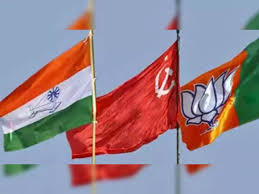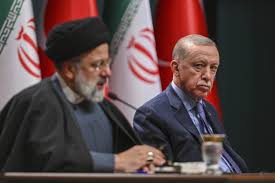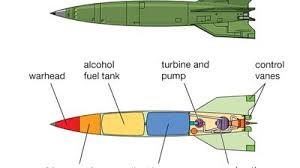Kerala
Featured
Kerala's Shifting Political Sands: BJP's New Strategy and the Enduring LDF-UDF Duopoly Face 2026 Assembly Test
Editor
Jun 16, 2025
min read
5 views

Kerala's political landscape, long characterized by its unique duopoly between the Left Democratic Front (LDF) and the United Democratic Front (UDF), is witnessing subtle but significant shifts, particularly with the Bharatiya Janata Party (BJP) intensifying its efforts to make inroads. While the LDF, led by the CPI(M), broke a four-decade-old pattern by securing a consecutive term in 2021, and the UDF, spearheaded by the Indian National Congress, strives to regain lost ground, the BJP's growing vote share and strategic realignments are injecting an unprecedented complexity into the run-up to the 2026 Assembly elections.
The traditional political narrative in Kerala has always revolved around the alternating fortunes of the LDF and UDF, a dynamic that has largely excluded any third significant force from gaining traction. However, the BJP's performance in the 2024 Lok Sabha polls, where its vote share climbed to 19.24% (up from 12% in 2021 Assembly elections), and its historic win in Thrissur, signal a potential paradigm shift. This rise, coupled with the appointment of technocrat-turned-politician Rajeev Chandrasekhar as the new Kerala BJP President in March 2025, underscores a calculated strategy to appeal to a broader demographic beyond its traditional Hindu base.
Chandrasekhar's appointment is a clear departure from the party's previous emphasis on hardcore Hindutva leaders. His focus on a 'development' agenda, aimed at creating jobs and opportunities, is designed to resonate with Kerala's development-oriented populace and sidestep ideological controversies. The party is consciously trying to shed its 'outsider' image by absorbing leaders from other parties and integrating them into its state unit. Furthermore, the BJP is strategically targeting specific constituencies in the upcoming local body polls (2025) in cities like Thiruvananthapuram, Thrissur, and Kollam, focusing on areas with significant Congress, Nair Service Society (NSS), and Christian strongholds. This 'social engineering' approach aims to attract upper-caste Hindu votes, traditionally aligned with the Congress, and crucially, a segment of the Christian electorate.
The LDF, under Chief Minister Pinarayi Vijayan, is keenly aware of these evolving dynamics. Having secured a second consecutive term, a feat previously unachieved, the CPI(M) is now strategizing to make history with a third term. The party's recent state conference in March 2025 outlined a dual strategy: portraying itself as a victim of combined opposition forces (Congress and BJP) and simultaneously as the sole purveyor of 'big ticket development' in the state. The LDF also accuses the UDF of aligning with communal forces, particularly the Indian Union Muslim League (IUML) and fringe Islamist groups, in a bid to counter the BJP's perceived appeal to minority communities and to prevent a further erosion of its own support base among Muslims.
For the UDF, the stakes are exceptionally high. Having suffered two consecutive assembly election defeats, the Congress and its allies are in a 'do or die' situation. The recent leadership rejig in the Kerala Pradesh Congress Committee (KPCC), with Sunny Joseph taking charge in May 2025, aims to revitalize the party and present a united front. The UDF's immediate priority is to strengthen the coalition by resolving internal issues and working closely with various social groups, with the 2025 local body elections serving as a crucial litmus test ahead of the 2026 Assembly polls. The Nilambur by-election, triggered by the resignation of independent MLA P.V. Anvar, is seen as an early indicator of potential shifts in coalition dynamics and a proving ground for the new KPCC leadership.
Adding another layer of intrigue is the speculation surrounding Shashi Tharoor's potential as a chief ministerial candidate for the Congress. Amidst reports of party disarray and growing disenchantment among UDF partners, some believe that projecting Tharoor could significantly improve the UDF's prospects, potentially even swaying allies like the Jose K. Mani-led Kerala Congress (M), currently an LDF partner, to reconsider their alignments.
Furthermore, the emergence of groups like the Christian Association & Alliance For Social Action (CASA), exploring plans to float a 'nationalist' political outfit aligned with the BJP, could further fragment traditional vote banks. CASA, claiming support from 17 Christian denominations, aims to fill the perceived void left by the weakening Kerala Congress (a traditional Christian party) and openly supports the BJP on issues like the Citizenship Amendment Act. This development highlights the BJP's multi-pronged approach to expand its influence by directly appealing to various community groups.
As Kerala marches towards the 2026 Assembly elections, the enduring LDF-UDF contest is set to be profoundly influenced by the BJP's assertive entry and its strategic pursuit of new voter segments. The upcoming local body elections will serve as crucial indicators, providing early insights into the efficacy of these new political strategies and the evolving preferences of the Keralite electorate.
Editor
League Manager Editorial Team





Leave a Comment